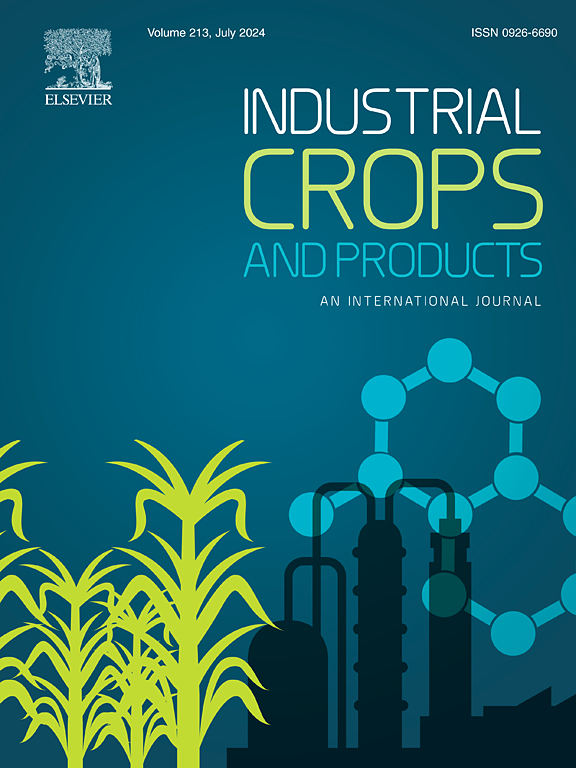天然橡胶/铜改性椰壳活性炭复合弹性体介电材料:结合实验和密度泛函理论研究
IF 6.2
1区 农林科学
Q1 AGRICULTURAL ENGINEERING
引用次数: 0
摘要
本研究考察了铜改性活性炭(Cu-AC)填充天然橡胶(NR)复合材料的介电性能和力学性能的增强,采用实验表征和密度泛函理论(DFT)模拟来探索结构-性能关系。分别以5、10、15 phr的Cu-AC负载制备了NR复合材料,并与纯活性炭(AC)增强的NR复合材料进行了性能比较。研究了Cu-AC含量对交联密度、膨胀行为和固化特性的影响。SEM和EDX分析证实了Cu-AC颗粒的良好分散,特别是在低负荷下。力学测试显示,拉伸强度和断裂伸长率显著增加,在10 phr Cu-AC下性能达到最佳平衡。电介质分析表明,含有15 phr Cu-AC的复合材料在1 Hz下的介电常数约为20,是纯NR的2.68倍。这种增强与符合Maxwell-Wagner-Sillars效应的界面极化以及Cu-AC形成导电通路有关。然而,由于在较高负载下机械强度降低,10 phr Cu-AC复合材料被确定为最佳配方,提供了良好的介电和机械性能组合。DFT计算支持了这些发现,证明了强的nr -填料相互作用,高吸附能(Eads)和铜掺杂表面的显著电荷转移。这些结果突出了Cu-AC作为增强和功能性添加剂在NR复合材料中的多功能潜力,可用于柔性电子、介电弹性体和储能应用。本文章由计算机程序翻译,如有差异,请以英文原文为准。

Elastomeric dielectric materials from natural rubber/copper-modified coconut-shell-derived activated carbon composite: Combined experimental and density functional theory study
This study examines the enhanced dielectric and mechanical properties of natural rubber (NR) composites filled with copper-modified activated carbon (Cu-AC), employing both experimental characterization and density functional theory (DFT) simulations to explore structure-property relationships. NR composites were prepared with Cu-AC loadings of 5, 10, and 15 phr, and their performance was compared to those reinforced with neat activated carbon (AC). The effects of Cu-AC content on crosslink density, swelling behaviour, and curing characteristics were evaluated. SEM and EDX analyses confirmed good dispersion of Cu-AC particles, particularly at lower loadings. Mechanical testing revealed a significant increase in tensile strength and elongation at break, with the best balance of properties performed at 10 phr Cu-AC. Dielectric analysis showed increased interfacial polarization and charge storage, with the composite containing 15 phr Cu-AC exhibiting a dielectric constant of around 20 at 1 Hz, which is 2.68 times higher than that of neat NR. This enhancement was associated with interfacial polarization consistent with the Maxwell–Wagner–Sillars effect and the formation of conductive pathways by Cu-AC. However, due to reduced mechanical strength at higher loadings, the 10 phr Cu-AC composite was identified as the optimal formulation, offering a favourable combination of dielectric and mechanical performance. DFT calculations supported these findings, demonstrating strong NR–filler interactions, high adsorption energy (Eads) and significant charge transfer for copper-doped surfaces. These results highlight the multifunctional potential of Cu-AC as a reinforcing and functional additive in NR composites for use in flexible electronics, dielectric elastomers, and energy storage applications.
求助全文
通过发布文献求助,成功后即可免费获取论文全文。
去求助
来源期刊

Industrial Crops and Products
农林科学-农业工程
CiteScore
9.50
自引率
8.50%
发文量
1518
审稿时长
43 days
期刊介绍:
Industrial Crops and Products is an International Journal publishing academic and industrial research on industrial (defined as non-food/non-feed) crops and products. Papers concern both crop-oriented and bio-based materials from crops-oriented research, and should be of interest to an international audience, hypothesis driven, and where comparisons are made statistics performed.
 求助内容:
求助内容: 应助结果提醒方式:
应助结果提醒方式:


